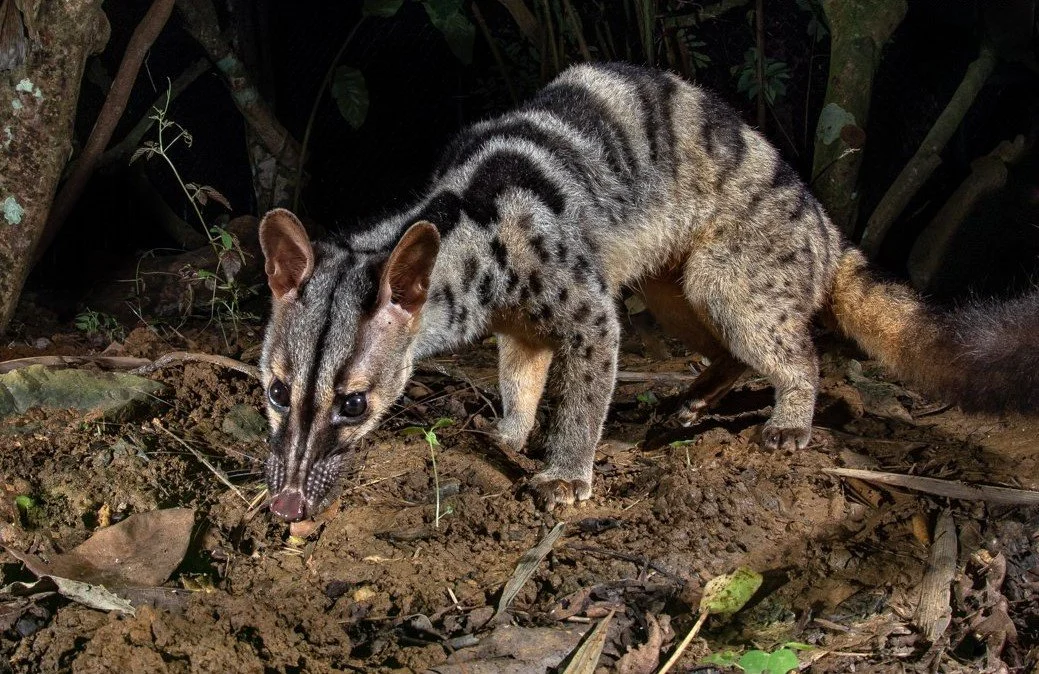Species
A collection of animal species from around the world.
*Sources for information and photos (unless they were taken by me) can be found at the bottom of each species profile.
Central Rock-Rat
The central rock rat lives in central Australia around and among rocks — sheltering in crevices during days that can reach a blistering 50°C (122°F). Threatened by bushfires and invasive predators, its range has shrunk by around 95%.
Paradox Frog
A paradox frog tadpole can grow to be 27 centimetres (11 in) long — the largest tadpole of any frog. It eventually metamorphoses into a shrunken adult frog, only some 7 centimetres (2.7 in) long.
Madame Berthe's Mouse Lemur
Madame Berthe's mouse lemur is the smallest primate in the world. On average, it measures 10 centimetres (3.9 in) plus a 13-centimetre (5-in) tail and weighs just 33 grams (1.2 oz) — lighter than a golf ball.
Blue-eyed Ground Dove
The blue-eyed ground dove was believed to be extinct for 75 years — until twelve were rediscovered in the Brazilian Cerrado in 2015. Current population estimates range from over 250 individuals to as few as 16.
Owston's Civet
Owston's civet is a cryptic creature from the Annamite Mountains, straddling the border of Vietnam and Laos. With its skinny snout, it sniffs and searches through leaf litter for its favourite food: earthworms.
Gollum Galaxias
Gollum galaxias — with their big eyes and flattened faces — are named for their resemblance to The Hobbit and The Lord of the Rings character. These 7-centimetre (2.8 in) fish live in the southern reaches of New Zealand and are considered 'critically endangered'.
Southern Pied-Babbler
Southern pied-babblers appoint a sentinel to stand watch while the rest of the family forages on the ground. The sentinel sings a “watchman’s song" — continuously updating its family with information — and if it spots danger, its song turns into a harsh alarm.
Horned Marsupial Frog
The horned marsupial frog has the largest eggs of any living amphibian. The female carries the eggs in a pouch on her back, each in its own chamber, until they emerge as fully-formed froglets.
Iriomote Cat
The Iriomote cat occupies the smallest habitat of any wild cat on Earth — found only on Japan's southern Island of Iriomote — with its current population estimated to be around 100 individuals.
Blakiston's Fish-Owl
Blakiston's fish-owl is one of, if not the largest owl species in the world, with a wingspan reaching 2 metres (6.6 ft) and a weight exceeding 4 kilograms (8.8 lb). It is endangered — it's estimated that less than 2,000 individuals hunt the cold rivers of northeast Asia.
Japanese Pygmy Squid
The Japanese pygmy squid — one of the world’s smallest cephalopods with a mantle length of just 16 mm (0.6 in) — hunts crustaceans up to twice its size. It paralyses them, then slips its mouthparts inside their exoskeletons to slurp out their insides, leaving their shells intact.
Pheasant-tailed Jacana
Pheasant-tailed jacana females are larger than the males. The species is also polyandrous — each female mates with multiple males and, in a single season, lays up to 10 clutches that are raised by different males in her harem.
Bull-headed Shrike
The bull-headed shrike's shrieking call ('kich-kich-kich') signals the approach of fall in Japan — in some regions, farmers use its call to time their work and avoid the winter frosts. The shrike's cries also serve as warnings, staking its claim over hunting grounds.
Samurai Crab
The samurai crab's shell resembles the face of a samurai warrior. A popular theory proposed that fishermen spared the crabs with the most face-like shells, throwing them back instead — selectively breeding the species to resemble a scowling samurai. While a neat idea, it's unlikely to be true.
Turtle Frog
The turtle frog of Western Australia uses its short but muscular front arms — rather than back legs like most frogs do — to dig more than a metre (>3.3 ft) beneath the soil. Adapted to semi-arid habitats far from water, its tadpoles develop inside their eggs and hatch as tiny frogs.
Cape Barren Goose
The Cape Barren goose is perhaps the least aquatic of all geese — it seldom enters water, except to save its chicks. An aggressively protective parent, it chases away larger animals, including humans, by battering them with the hard "wrist" bones on its wings and pecking with its knobby beak.
Brahminy Blind Snake
The Brahminy blind snake is also known as the 'flowerpot snake' because it often hides in the soil of flowerpots, resulting in its spread throughout most of the world. It looks and acts like a worm — some 13 cm (5 in) long and subterranean — but it's one of the world's smallest snake species.
Long-tailed Planigale
The long-tailed planigale — the world's smallest marsupial — measures just 5 centimetres (2 inches) in length. Its extremely flat, wedge-shaped head allows it to squeeze into narrow cracks in the soil, offering refuge from predators and the daytime heat of northern Australia.
Hopkin’s Rose Nudibranch
Hopkin’s rose nudibranch is a sea slug that lives in the tidepools along North America’s West Coast. It gets its rosy-pink pigment by eating pink bryozoans — tiny, colonial animals that form larger plant-like structures. Despite looking like bubblegum, its frilly pink appearance is thought to deter predators.
Hairy Frogfish
The hairy frogfish doesn't pursue prey. Instead, it wobbles along the sea floor, finds a hiding spot, and uses a worm-like appendage on its head to lure in a victim. Its body is covered in spines which resemble strands of hair — camouflaging it amongst seaweed, assisted by colour-changing abilities.






















